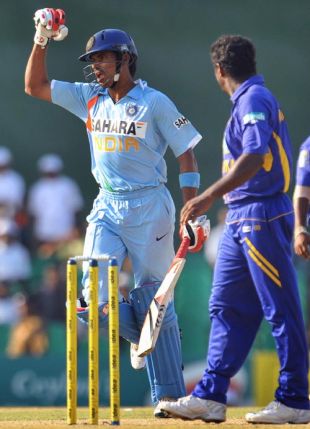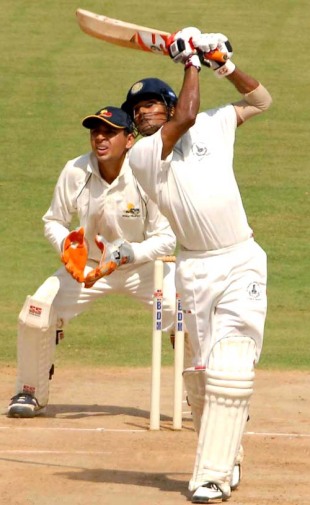Twist of faith
S Badrinath has withstood the slings and arrows of fortune, and added to his game without shaking its base
Nagraj Gollapudi
08-Sep-2008
|
|

|
When the selectors did not pick him for last month's ODI series in Sri Lanka, S Badrinath was in agony.
"I was truly disappointed. I was devastated," he recalled of the day he sat in front of the TV along with his wife, expecting his name to flash on the screen. Numbness invaded him minutes later when he realised he wasn't in the side.
The feeling was not alien for Badrinath, who had been there before; only, it was more intense this time. He had been sure his chance had come. So affected was he that he bared his emotions in public. "For God's sake, allow me to fail," he burst out in an interview, unable to understand what he needed to do to convince the five wise men on the national selection panel.
Like in the past, the only pill for the pain was cricket. "That evening I turned up at the ground, did my training," he said. "I had to continue playing the game. I love playing this game and whatever I have in my hand I will do to the best of my ability."
He found support from the likes of Sunil Gavaskar. "By saying what he did... he brought attention to the selectors' wandering minds that here was a player who had done no wrong and needed to be given a chance," Gavaskar wrote in one of his newspaper columns.
Closer home, VB Chandrasekhar, the former national and Tamil Nadu selector, who first saw Badrinath as an upcoming youngster during his performances for Guru Nanak College in Chennai, knew where Badrinath was coming from. "He was pushed into a corner and he was left with no choice."
Badrinath doesn't exactly have age on his side. He turned 28 on August 30. Athletes train all their life to be able to play at the top level, but as the years pass it gets difficult to keep the flame burning when the opportunities don't come along. It's even harder when, like in Badrinath's case, your contemporaries or those younger than you get the breaks ahead of you.
As fate had it, Badrinath was called into the Indian squad as a replacement for Sachin Tendulkar, who was injured. When he was last called up, during the ODI series at home against Australia in 2007, he didn't get a game. This time, though, he made his debut, in challenging conditions against Sri Lanka, and he let his bat do the talking, getting India out of a tight situation and forcing people to sit up and take notice.
Mahendra Singh Dhoni is generally averse to hyperbole, so his words was high praise indeed: "He's very talented, and that's why he is here," Dhoni said.
The man himself was modest about his contribution in his debut game. "I felt really good to be involved so much. I wasn't actually under any sort of pressure. I was quietly confident about myself," Badrinath said. "There is always uncertainty in sport. It is all about taking it as it comes and grabbing the opportunity and doing the job and being a good professional."
Your story, my story
During the IPL, Badrinath had the opportunity to spend time with an individual who had walked a similar path.
During the IPL, Badrinath had the opportunity to spend time with an individual who had walked a similar path.
As he approached the age of 30, with no sign that he would ever make it into the Australian line-up, Michael Hussey had reason to think he was going nowhere fast. He grew frustrated and distracted and his domestic cricket suffered as a result. But after a period of introspection where he made up his mind about exactly what he wanted, Hussey gathered himself together and started enjoying his game again, and eventually played his maiden Test.
Badrinath developed a strong acquaintance with Hussey in the Chennai Super Kings dressing room and soaked up all the lessons born of experience on offer. "The way they [the Australians] prepare themselves, the amount of dedication they show, the amount of professionalism they have, is totally different," Badrinath said during our first meeting, in Mumbai during the IPL. "I learnt a lot from [Matthew] Hayden and Hussey. I spoke to Hussey a lot, because I was amazed that he made his debut at 30. He helped me a lot."
Hearing from Hussey that he was a good player capable of doing a good job made a world of difference to Badrinath's confidence. "That inspired me, that a player of that class had faith in me and confidence in me. It does matter when someone compliments you or praises you or shows belief in you," Badrinath said.
| Hearing from Hussey that I was a good player capable of doing a good job inspired me, that a player of that class had faith in me and confidence in me | |||
He justified that faith, producing important cameos for the Super Kings, batting in various positions, on their way to the runner-up spot. Importantly, he switched gears depending on the situation and the role he was asked to fulfill. Mostly he batted in the middle- and lower-middle order, so his job was that of a hustler or a finisher - which only the experienced or the gifted manage to accomplish consistently.
In the very first game, where Hussey cracked a stupendous 115 not out, Badrinath adjusted quickly, coming in at No. 7 and giving strong support to the Australian with a patient 31 not out. In the middle stages of the tournament, where the Super Kings proved tentative, he calmed nerves more than once, most memorably in the last-ball thriller against Delhi. When he was promoted up the order after Hayden and Hussey had left on international duty, he made two consecutive half-centuries.
Chandrasekhar remembered how eyes rolled when he recommended Badrinath as one of the first recruits for the Super Kings. "People wondered why I was picking a grafter for Twenty20. But I felt particularly good when he went out and won matches for us. Finishing ability is what makes a good cricketer."
Technique plus temperament equals versatility
There is nothing imposing about Badrinath in person or physically as a batsman. He is lean, not built to be a big-hitter. His strengths lie elsewhere.
There is nothing imposing about Badrinath in person or physically as a batsman. He is lean, not built to be a big-hitter. His strengths lie elsewhere.
"He has a wonderful temperament," Chandrasekhar said, "not something you associate often with Tamil Nadu cricketers. He transformed from a dour batsman to somebody who was willing to be more creative and allow himself to play shots which were within his framework."
Badrinath himself testified as much. "I've been trying to be more innovative and trying to work out a plan around my game that fits within my scheme of things," he said, when asked if he had changed his technique. "In my domestic cricket I've become more aggressive and that has given me more confidence and I've started to believe I can make a difference."
He is a player in the mould of Rahul Dravid, who is still perhaps the most technically accomplished batsman in contemporary cricket. "Technique is my base and once the base is strong it is easy to work around. Now I'm playing more shots all around the park. I was a dominant batsman on the off side; I've now become strong on both sides of the wicket," Badrinath said.
Even if he does not say much about his expectations of a spot in the Test team in light of the anticipated upcoming middle-order vacancies, his supporters believe he has earned the right to stake his claim by virtue of having toiled for years on the unattractive domestic circuit. After a slow start, following which he was dropped in his second domestic season, Badrinath returned more determined, and soon began to reap rewards.

| ||
A regular in the A team, Badrinath has been piling up big scores against various oppositions home and away. Before the series against Australia A started, he had four unbeaten hundreds in his last four appearances for India A, including a double-century against South Africa A in 2007. In the 2007-08 domestic season he scored 990 runs at an average of 66 in 12 matches. Recently, in the Emerging Players tournament in Australia last July, he led from the front, cracking 95 and 83 not out.
WV Raman, Tamil Nadu's coach for the last two seasons, wishes people would stop looking at Badrinath as a one-dimensional player fit only for the longer form of the game. By doing well in the IPL, Badrinath has demonstrated that he can play the shorter version, Raman said. "Not the other way round. People maintain that he is a duration game player, but if someone saw him against the South Africa A team last year he would see how he changed as a batsman."
Over the years Badrinath stood by and watched as the likes of Gautam Gambhir, and even younger players such as Rohit Sharma and Manoj Tiwary, got called up into the national squads. He looked doomed to be the good guy who finished last. Now that his chance seems to have arrived, he wants to enjoy the moment.
In Dambulla he walked in with India at a precarious 75 for 5 chasing 143. It was left to him and Dhoni to hang around and make sure the job was done. From ball one he stuck to his captain's brief of keeping it simple. "Dhoni was giving me small tips on how to go about my batting and how to play the likes of [Ajantha] Mendis," Badrinath said. Working the singles and twos, the pair brought India to the brink of victory.
When eight were needed Dhoni was out, and Harbhajan Singh fell quickly soon after. All it would have taken to knock India out cold were three unplayable deliveries from the dangerous Sri Lankan spinners. But Badrinath stayed calm and stuck to his strategy of nudging and steering the ball around, using his wrists to find the gaps for singles. The winning run duly came off a push to extra-cover.
"It is mentally that I've improved," Badrinath said. "Once the player starts to believe he can do it and it starts to happen his confidence level goes up."
Nagraj Gollapudi is an assistant editor at Cricinfo